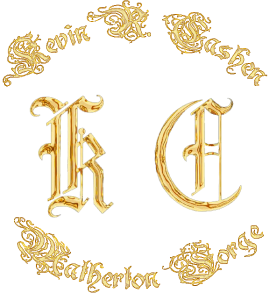I have spent my entire life studying blades that history has proven to be the “real deal” to further my understanding of the physics and design of actual blade use. Growing up in rural Michigan, the qualities of a good hunting knife became apparent to me early on, but my passion for blades of all shapes and sizes inspired me to study the art of blade design throughout history.
The first lesson I learned was that you cannot master blade design without a personal understanding of the blades function. For any modern knife this is as simple as seriously using the blade in the task for which it was intended. But for real weapons this poses a serious legal and ethical problem. There are plenty of people claiming to make edged weapons, based on their experience in their use today, but very few of the blades resemble the proven blades of the past. I decided early on that the surest route to making a proper sword would be to study the work of the masters, the people who actually did live and die by the sword on the battlefields of old. But it is even deeper than appearances, because the second lesson I learned was that one cannot recreate real swords and daggers from a photograph. Form absolutely follows function in an ancient edged weapon, and one does not truly understand this until you hold it in your hands and feel the effectiveness of its design.
In my pursu it of understanding blades, I have traveled the world to study originals from the Bronze Age to the present in the most respected museums and private collections that my reputation has gained me access to . Often this has resulted in a cooperation that allowed me to obtain my invaluable data while sharing insights into construction techniques in return. Detailed measurements of cross sections, geometries, proportions, mass distribution and the materials used has given me irreplaceable insights to accurately recreate these fearsome blades of the past but has also helped me make better blades of all shapes and sizes.
it of understanding blades, I have traveled the world to study originals from the Bronze Age to the present in the most respected museums and private collections that my reputation has gained me access to . Often this has resulted in a cooperation that allowed me to obtain my invaluable data while sharing insights into construction techniques in return. Detailed measurements of cross sections, geometries, proportions, mass distribution and the materials used has given me irreplaceable insights to accurately recreate these fearsome blades of the past but has also helped me make better blades of all shapes and sizes.
The most accurate recreation of an existing artifact begins with detailed measurement and documentation, with care and preservation always a priority. Every dimension, geometry, weight, and material observation is carefully recorded along with photography. The history of the work as well as biographical information of the original maker that may be available is studied to glean any information that may contribute to a better understanding of the object. A recent project involving a sword from the American Revolution resulted in a month’s worth of study of the family, business and work of a New York silversmith to gain an understanding to best reproduce the chape and throat of the scabbard he had made in 1776.
 All of this information is brought together in a detailed plan for the work so that I can recreate the original as close as possible. This level of historical accuracy is some of the most challenging work I have done, as one small slip in removing material can result in starting all over again. While original blades, of my design, are nowhere near as challenging they have certainly benefited from the lessons learned in the process, and I now carefully design every blade I make before lighting the forge and keep it as a permanent record to refer to and learn from in the future.
All of this information is brought together in a detailed plan for the work so that I can recreate the original as close as possible. This level of historical accuracy is some of the most challenging work I have done, as one small slip in removing material can result in starting all over again. While original blades, of my design, are nowhere near as challenging they have certainly benefited from the lessons learned in the process, and I now carefully design every blade I make before lighting the forge and keep it as a permanent record to refer to and learn from in the future.


